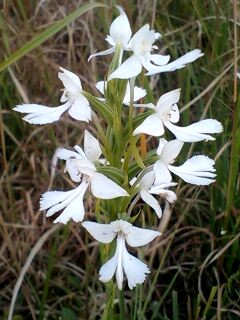
The ornamental orchid species Phalaenopsis hieroglyphica is native to certain islands of the Philippines. Its flowers are creamy white with transverse markings that resemble glyphs. Through hybridization, growers have successfully created flowers with different shapes and colors while retaining the glyphs. Since 1975, the species has been protected under Appendix II of the Convention on International Trade in Endangered Species of Wild Fauna and Flora (CITES).

Phalaenopsis equestris is a flowering plant of the orchid genus Phalaenopsis and native to Philippines and Taiwan. The inflorescence has 10 to 20 flowers of about 25 mm (1 in) diameter.
Epidendrum polystachyumHBK (1816) is an epiphytic orchid, which grows wild in seasonally dry forests on the western slopes of the Andes in Ecuador and Peru at altitudes near 2 km.

Cattleya maxima is a species of orchid in subfamily Epidendroideae found from Ecuador to Peru.

Habenaria dentata is a species of orchid native to the Himalaya, China, India, Indochina, Thailand and Myanmar. It is also found at Phalee. The whole plant is about 35 to 80 cm in height. It has a smooth round tuber that give rise to a single plant. Lower part of stem sheathed, middle leafy and upper part bracteate. Leaves 4 to 6 cm long, oblong to elliptic, 5 nerved, sometimes 7 also, the base of the leaf narrowed into a long tubular sheath. Spike 4 to 8 cm long, laxly flowered. Sepals sub-equal, broadly ovate, acute, spreading, the lateral pair sub-erect. Petals narrowly oblong, sub-acute, curved inwards, shorter than the sepals. Lip as long as the sepals, variable in breadth, with large cuneate or rounded, fimbriate or crenate side lobes and a small oblong entire apical lobe. Spur infundibuliform at the base, slender laterally compressed, geniculate, sub-clavate below the knee, longer than the shortly stalked beaked ovary. Stigmas separated by the area in the centre by the orifice of the spur. It generally blooms in August- September.
Epidendrum lanipes is an epiphytic sympodial orchid with spindle-shaped stems native to the montane tropical rainforest of Bolivia, Colombia, Ecuador, and Peru at altitudes ranging from 0.8 to 1.4 km.
Epidendrum adenoglossum is an orchid known primarily from its type herbarium specimen, Mathews 1073, collected in Peru near Pangoa. When Lindley published the name, he placed the species in the subgenus E. subg. SpathiumLindl. (1841). In 2005, Hágsater & Soto designated this species as the lectotype of E. subg. SpathiumLindl. (1841).

Cattleya rex is a species of epiphytic orchid of showy white flowers, native to montane forests in Peru and Bolivia.
Epidendrum cochlidium is a neotropical orchid which can grow both terrestrially and epiphytically in Peru and Venezuela at altitudes ranging from 1.2 km to 2.9 km.

Epidendrum cylindrostachys is an epiphytic orchid native to the mountainous rainforest of Colombia and Peru, at altitudes near 2.5 km. According to the World Checklist, this binomial has no synonyms or homonyms.

Encyclia citrina is a species of orchid with a strong lemon fragrance. Its petals are golden yellow with varying degrees of white crenulations in the lip. The plant may be upright or pendant, but the flowers are always pendant. It is also known as the tulip orchid due to its flowers' rounded cup-like shape. It has been referred to for generations as costicoatzontecoxòchitl, meaning "flower in the form of yellow serpent head", by the Nahuas.

Vanda wightii is a species of orchid from southern India and Sri Lanka. For some time it was thought to be extinct after being described in 1849. The species was however rediscovered and it is now known from India. It is closely related to Vanda thwaitesii. The species was named by Reichenback after the botanist and collector Robert Wight. 1.
Pachystoma nutans, is a species of plant in the orchid family. It is endemic to Myanmar. It was first described by Sing Chi Chen and Yi Bo Luo in 2002. The type specimen of Pachystoma nutans was previously overlooked among unidentified Eulophia species at the Royal Botanic Garden herbarium in Edinburgh. It is only known from the type specimen, which was collected near Mong Yaw, Myanmar.
Passiflora quetzal is a species of flowering plant native to Mexico and Guatemala described in 2004. It is named after the quetzal, which inhabits the area.

Pseudovanilla foliata, commonly known as the great climbing orchid, is a plant in the orchid family native to Queensland, New South Wales, and New Guinea. It is a terrestrial orchid with a vining vegetative habit, climbing by means of adventitious roots produced at nodes. Its leaves are reduced, and the species is considered to be at least partially mycoheterotrophic.

Lepanthes kokonuko is a species of orchid from southern Colombia. L. kokonuko can be easily recognized by its caespitose medium-sized plants, elliptical coriaceous leaves, long loosely, flexuous and distichous inflorescences; strongly revolute lateral sepals, transversely bilobed petals with the upper lobe lanceolate (hornlike), and a bilaminate lip with the blades ovoid–lanceolate with a bipartite appendix.
Jejewoodia is a genus of flowering plants belonging to the family Orchidaceae.

Phalaenopsis kapuasensis, also known as the Kapuas Hulu Phalaenopsis, is a species of orchid endemic to Borneo. The specific epithet kapuasensis refers to the indonesian locality Kapuas Hulu, from which the type specimen was obtained.

Phalaenopsis natmataungensis is a species of orchid endemic to Myanmar. The specific epithet natmataungensis refers to Nat Ma Taung, Myanmar. The mountain slopes are covered in natural, seasonally dry forests that are mainly composed of deciduous trees. These areas are generally not disturbed by agriculture.

Phalaenopsis venosa, is a species of orchid endemic to Sulawesi, Indonesia. The specific epithet venosa, from the Latin venosus meaning veiny, refers to the floral colouration.













